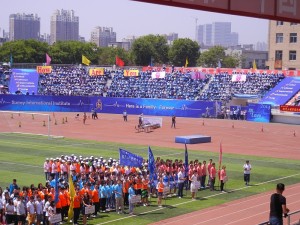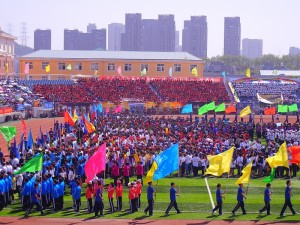
Surrey goes all out, image-wise. They’re the blue-clad spectators, here during the “march of the somebody-or-others”. Like me.
When I wrote last June about my first in-depth experience of a Chinese university’s annual “Sports Meeting” — a low-performance track and field meet — I was still quite flabbergasted by the whole thing. It was an incredible show that put the circus into the “bread and circuses” recipe for keeping the mass of people contented and amused, and yet everybody takes it so seriously. I swung wildly between my reflexive love for young people giving their hearts to sport — even for a day — and my disgust with what a paltry, occasionally harmful and clearly manipulated “opportunity” the kids actually had. I liked that athletic kids got to run and jump, and hated that many participants and nearly all the spectators weren’t there by any shade of their own choice. The whole thing really wasn’t for the students at all. Mianzi, it’s called. “Face”: making the university and its officials look good, and the university experience a “colourful” one for a day or two between the grey student months. Look, you had the Sports Meeting. Wasn’t that fun? Umm.
I was also a little ticked that I and younger foreign staff hadn’t been invited to join in. Oh, we wore our hats and marched (badly) in the mini-olympian opening ceremonies, but there were faculty races, too, but no wai guo ren had been asked. Then, a week ago, I got a surprise text, asking me to join one of the funky sprint relays that Chinese meets feature. In this case, it was six men and five women, with two 100-metre, six 200-metre and three 400-metre legs. In a “training session” last Monday, I got smoked by young Mr. Zou in a 400 trial, which meant that I’d be a 200 Man, with a shorter distance to lose time in. The goofy thing is that 50-something males – well, at least one that I know of – can still get pumped about silly athletic contests. (Okay, love, I’ve got a week to lose five pounds! Did, too.)


